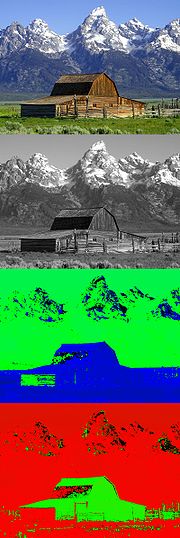
YDbDr
Encyclopedia

SECAM
SECAM, also written SÉCAM , is an analog color television system first used in France....
analog terrestrial colour television
Television
Television is a telecommunication medium for transmitting and receiving moving images that can be monochrome or colored, with accompanying sound...
broadcasting standard, which is used in France
France
The French Republic , The French Republic , The French Republic , (commonly known as France , is a unitary semi-presidential republic in Western Europe with several overseas territories and islands located on other continents and in the Indian, Pacific, and Atlantic oceans. Metropolitan France...
and some countries of the former Eastern Bloc
Eastern bloc
The term Eastern Bloc or Communist Bloc refers to the former communist states of Eastern and Central Europe, generally the Soviet Union and the countries of the Warsaw Pact...
. It is very close to YUV
YUV
YUV is a color space typically used as part of a color image pipeline. It encodes a color image or video taking human perception into account, allowing reduced bandwidth for chrominance components, thereby typically enabling transmission errors or compression artifacts to be more efficiently...
(PAL
PAL
PAL, short for Phase Alternating Line, is an analogue television colour encoding system used in broadcast television systems in many countries. Other common analogue television systems are NTSC and SECAM. This page primarily discusses the PAL colour encoding system...
) and its related colour spaces such as YIQ
YIQ
YIQ is the color space used by the NTSC color TV system, employed mainly in North and Central America, and Japan. It is currently in use only for low-power television stations, as full-power analog transmission was ended by the U.S. Federal Communications Commission on 12 June 2009...
(NTSC
NTSC
NTSC, named for the National Television System Committee, is the analog television system that is used in most of North America, most of South America , Burma, South Korea, Taiwan, Japan, the Philippines, and some Pacific island nations and territories .Most countries using the NTSC standard, as...
), YPbPr
YPbPr
' is a color space used in video electronics, in particular in reference to component video cables. is the analog version of the YCBCR color space; the two are numerically equivalent, but YPBPR is designed for use in analog systems whereas YCBCR is intended for digital video. cables are also...
and YCbCr
YCbCr
YCbCr or Y′CbCr, sometimes written or , is a family of color spaces used as a part of the color image pipeline in video and digital photography systems. Y′ is the luma component and CB and CR are the blue-difference and red-difference chroma components...
.
YDbDr is composed of three components -
 ,
,  and
and  .
.  is the luminance,
is the luminance,  and
and  are the chrominance
are the chrominanceChrominance
Chrominance is the signal used in video systems to convey the color information of the picture, separately from the accompanying luma signal . Chrominance is usually represented as two color-difference components: U = B' − Y' and V = R' − Y'...
components, representing the red and blue colour differences.
Formulas
The three component signals are created from an original RGB (red, green and blue) source. The weighted values of ,
,  and
and  are added together to produce a single
are added together to produce a single  signal, representing the overall brightness, or luminance, of that spot. The
signal, representing the overall brightness, or luminance, of that spot. The  signal is then created by subtracting the
signal is then created by subtracting the  from the blue signal of the original RGB, and then scaling; and
from the blue signal of the original RGB, and then scaling; and  by subtracting the
by subtracting the  from the red, and then scaling by a different factor.
from the red, and then scaling by a different factor.These formulae approximate the conversion between the RGB colour space and YDbDr.

From RGB to YDbDr:

From YDbDr to RGB:

You may note that the
 component of YDbDr is the same as the
component of YDbDr is the same as the  component of YUV.
component of YUV.  and
and  are related to the
are related to the  and
and  components of the YUV
components of the YUVYUV
YUV is a color space typically used as part of a color image pipeline. It encodes a color image or video taking human perception into account, allowing reduced bandwidth for chrominance components, thereby typically enabling transmission errors or compression artifacts to be more efficiently...
colour space as follows:

There is also a variety of the PAL
PAL
PAL, short for Phase Alternating Line, is an analogue television colour encoding system used in broadcast television systems in many countries. Other common analogue television systems are NTSC and SECAM. This page primarily discusses the PAL colour encoding system...
broadcasting standard, PAL-N, that uses the YDbDr colour space.
See also
- YUVYUVYUV is a color space typically used as part of a color image pipeline. It encodes a color image or video taking human perception into account, allowing reduced bandwidth for chrominance components, thereby typically enabling transmission errors or compression artifacts to be more efficiently...
- related colour system - PAL#Technical details - some information on PAL-N

